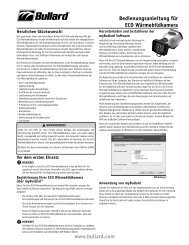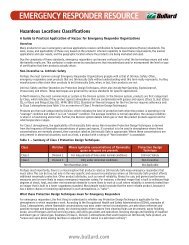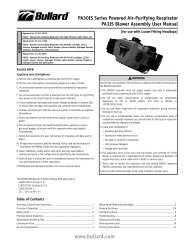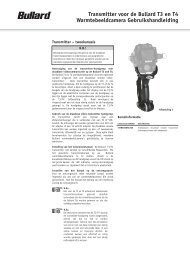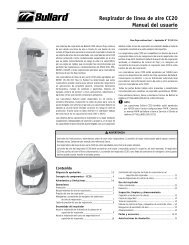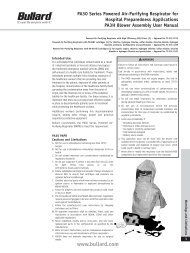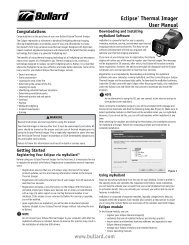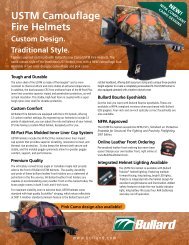RT Series Respirator Hood User Manual www.bullard.com
RT Series Respirator Hood User Manual www.bullard.com
RT Series Respirator Hood User Manual www.bullard.com
Create successful ePaper yourself
Turn your PDF publications into a flip-book with our unique Google optimized e-Paper software.
Operations / Breathinig Air Requirements<br />
4<br />
Operations<br />
Protection<br />
<strong>Respirator</strong>y<br />
The <strong>RT</strong> <strong>Series</strong> respirator is NIOSH approved (TC-19C-412) as a Type C<br />
continuous-flow supplied air respirator. It can be worn for general purpose<br />
applications, including pharmaceutical manufacturing, chemical and pesticide<br />
handling, tank cleaning, spray painting, and other industrial or agricultural<br />
applications in which hazardous <strong>com</strong>pounds are present.<br />
The <strong>RT</strong> <strong>Series</strong> respirator is not approved for use in any atmosphere<br />
immediately dangerous to life or health (IDLH), or from which the wearer<br />
cannot escape without the aid of the respirator. IDLH is defined in 29 CFR<br />
1910.134(b)<br />
Head<br />
<strong>RT</strong> <strong>Series</strong> respirator hoods DO NOT provide head protection.<br />
Face<br />
<strong>RT</strong> <strong>Series</strong> respirator hoods DO NOT provide face protection. If face protection<br />
is required, use the Bullard 20TICH or 20SICH model.<br />
Eyes<br />
<strong>RT</strong> <strong>Series</strong> respirator hoods DO NOT provide eye protection. Wear approved<br />
safety glasses or goggles at all times.<br />
Ears<br />
<strong>RT</strong> <strong>Series</strong> respirator hoods DO NOT provide hearing protection. Use properly<br />
fitted earmuffs, earplugs or other protection when exposed to high noise<br />
levels.<br />
<strong>RT</strong> <strong>Series</strong> <strong>Respirator</strong> Breathing Air Requirements<br />
Air Quality<br />
WARNING<br />
The <strong>RT</strong> <strong>Series</strong> respirator must be supplied with clean, breathable air,<br />
Grade D or better, at all times. This respirator does NOT purify or filter<br />
out contaminants. Failure to heed these warnings could result in death<br />
or serious injury.<br />
Respirable, breathable air must be supplied to the point-of-attachment of<br />
the approved Bullard air supply hose. The point-of-attachment is the point<br />
at which the air supply hose connects to the air source. A pressure gauge<br />
attached to the air source is used to monitor the pressure of air provided to<br />
the respirator wearer (see Figure 2).<br />
Supplied breathing air must AT MINIMUM meet the requirements for Type 1<br />
gaseous air described in the ANSI/Compressed Gas Association Commodity<br />
Specification G-7.1 for Grade D or higher quality as specified by Federal<br />
regulations 42 CFR, Part 84.141(b) and 29CFR1910.134(i).<br />
The requirements for Grade D breathable air include:<br />
Oxygen.................................................19.5-23.5%<br />
Hydrocarbons (condensed) in mg/m3 of gas . . . . . . . . . . . . . . . 5 mg/m3 max.<br />
Carbon monoxide.........................................10 ppm max.<br />
Carbon dioxide........................................1,000 ppm max.<br />
Odor............................................................*<br />
No toxic contaminants at levels that make air unsafe to breathe.<br />
*Specific measurement of odor in gaseous air is impractical. Air may normally<br />
have a slight odor. The presence of a pronounced odor should render the air<br />
unsatisfactory.<br />
Contact the Compressed Gas Association (1725 Jefferson Davis Highway,<br />
Arlington, VA 22202) or <strong>www</strong>.cganet.<strong>com</strong> for <strong>com</strong>plete details on Commodity<br />
Specification G-7.1.<br />
Air Source<br />
Locate the source of supplied air, whether it is a breathing air <strong>com</strong>pressor<br />
or an ambient air pump, such as a Bullard Free-Air® pump, in a clean air<br />
environment. Locate the air source far enough from your work site to ensure<br />
the air remains contaminant-free. Always use an inlet filter on your air<br />
source.<br />
Use suitable after-cooler/dryers with filters, and carbon monoxide monitors<br />
and alarms, as necessary to assure clean, breathable air at all times.<br />
Compressed air should be regularly sampled to be sure that it meets Grade D<br />
requirements.<br />
<strong>RT</strong> <strong>Series</strong> <strong>Respirator</strong> Breathing Air Pressure<br />
Air pressure should be monitored at the point-of-attachment while operating<br />
this respirator. A reliable air pressure gauge must be present to permit you to<br />
monitor pressure during actual respirator operation.<br />
Special or Critical <strong>User</strong>’s Instructions<br />
The Breathing Air Pressure Table (see page 5) defines the air pressure ranges<br />
necessary to provide <strong>RT</strong> <strong>Series</strong> respirators with a volume of air that falls<br />
within the required range of 6-15 cfm or 170-425 lpm (Ref. 42 CFR, Part 84,<br />
Subpart J, 84.150).<br />
Make sure you understand the information in the Breathing Air Pressure Table<br />
before using this respirator.<br />
1. Determine the type of air source you are using (Column 1), then find your<br />
flow control valve/climate control device (Column 2).<br />
2. Be sure your Bullard air supply hose (Column 3) is approved for use with<br />
your flow control valve/climate control device.<br />
3. Determine that your Bullard air supply hose is within the approved length<br />
(Column 4).<br />
4. Make sure you have not exceeded the maximum number of hose sections<br />
(Column 5).<br />
5. Set the air pressure at the point-of-attachment within the required<br />
pressure range (Column 6) for your flow control valve/climate control device,<br />
and air supply hose type and length.<br />
<strong>RT</strong> <strong>Series</strong> <strong>Respirator</strong> Breathing Air Supply Hoses<br />
and Hose Fittings<br />
NIOSH approved Bullard air supply hose(s) MUST be used between the<br />
breathing tube connection fitting on the wearer’s belt and the point-ofattachment<br />
to the air supply.<br />
NIOSH approved Bullard quick-disconnect fittings MUST be used to connect<br />
V5 or V20 hose lengths together. When connecting lengths of V10 hose, only<br />
use Bullard V11 hose-to-hose adapters. Secure connection(s) until wrenchtight<br />
and leak-free. Total connected hose length and number of hoses MUST<br />
be within the ranges specified on the Breathing Air Pressure Table (see page<br />
5).<br />
The breathing tube connection fitting MUST be secured to the belt that is<br />
supplied with this respirator. Securing the breathing tube connection helps<br />
prevent the air supply hose from snagging, disconnecting or pulling the<br />
respirator hood off your head.<br />
<strong>www</strong>.<strong>bullard</strong>.<strong>com</strong><br />
WARNING<br />
Failure to supply the minimum required pressure at the point-of-attachment<br />
for your hose length and <strong>RT</strong> respirator type will reduce airflow and<br />
could result in death or serious injury.



